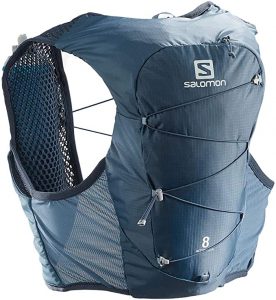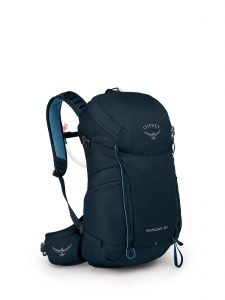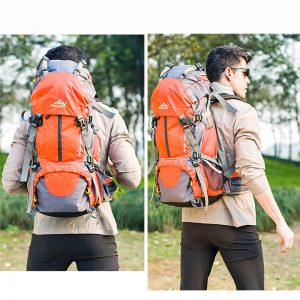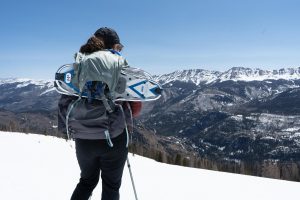Picking a backpack can be hard. You might have an idea of what to pack, but what size backpack do you need for the trip you’re taking? You may ask yourself questions like “What is the difference between backpack sizes? What backpack size do I need? How much can I fit in a backpack?”
We have the answers! In this guide to backpack sizes, we’ll teach you everything you need to know about backpack sizes and what can fit in your backpack at different volumes. We’ll show you how to take a torso measurement for backpack sizing to know exactly what size of backpack you need, and we’ll explain backpack sizing for trips of different lengths. Keep reading to discover the ins and outs of backpack sizing and which volume of bag to select as the perfect companion for your next excursion.
The Importance of Sizing Your Backpack
Selecting your backpack can make or break any trip you’re planning to take. After all, you’re going to be lugging it with you everywhere you go, so you’ll need a backpack that is big enough to carry all your essentials, but small enough to be easily bolstered over long distances. These factors may change depending on your body type and the location or duration of your trip, so we have provided a complete guide to teach you all about how backpack volume and sizing works as well as the many different options available so you can find just the right fit for your unique needs.
Backpack Capacity By Use
| Duration of Hike | Recommended Backpack Capacity |
| Half-Day Hike (<4 hours) | 20 liters or less |
| Full-Day Hike (>4 hours) | 20-40 liters |
| 1-3 Night Hike | 40-50 liters |
| 3-5 Night Hike | 50-70 liters |
| 5+ Night Hike | 80-110+ liters |
It may be difficult at first, especially when buying online, to visualize just how much a 50L backpack can carry. A helpful way to imagine the amount of space is to think of a common item that is measured using liters, such as a 2L bottle of soda. The capacity of a backpack measured in liters will be roughly equivalent to twice the number of soda bottles you can dump into it. For example, a 50L backpack will theoretically be able to hold about 25 bottles of soda, which is much easier to visualize.
Overview of Backpack Volumes
Backpacks are different from other types of luggage because rather than categorizing them based on their dimensions, manufacturers group backpacks together based on their carrying capacity or volume. The carrying capacity of a backpack is the sum of the carrying space across all its compartments and pockets, not just the main compartment. Volume is the most essential aspect in determining which type of backpack you need because it tells you exactly how much you will be able to carry throughout your expedition.
The typical units of measurement when discussing a backpack’s volume are either liters or cubic inches. For reference, 1 liter is equivalent to 61 cubic inches. The most popular of these units, however, is liters, so that is what we will be focusing on for this article.
Types of Backpacks
Now that you have an idea of how volume is measured in backpacks, it’s time to make the first step towards selecting your perfect backpack. Before worrying about exact sizing for your body type, you need to use the details of your trip, mainly the destination and duration of the excursion, to determine which volume of backpack you will need to be comfortable from start to finish. Below, we have outlined each type of backpack based on carrying capacity and explained the various situations in which you may find it useful.
0-10 Liters

Backpacks in this range are the first in a category known as daypacks because you cannot fit much more than the essentials inside them, meaning you will only be taking them out on single-day expeditions. Even then, backpacks this small are meant for minimalist hikers who only have in mind to bring along the absolute necessities. Trail running packs and vests also often fall in this category. You can expect to fit the following in a 0-10L backpack:
- Water bottle (these packs often do not have external water pouches)
- 1-2 snacks
- A lightweight jacket
- Minimum first aid supplies
10-20 Liters
The next installation up in the daypack category are the 10-20L backpacks. Once again, you will not be taking a backpack this small overnight anywhere; however, it is big enough for the minimalist hiker crowd to take along on all-day trail runs, which will require a decent amount of food to refuel. You can expect to fit the following in a 10-20L backpack:
- Enough food for a decent lunch
- A headlamp
- A lightweight jacket or hoodie
- 2L water bottle or hydration pack
- Some first aid supplies
20-30 Liters
20-30L backpacks are the largest option when it comes to recommended daypack sizes, with 30L being one of the more popular size options for daypacks in particular. These backpacks make a great accompaniment for more rigorous all-day activities such as rock climbing and can fit just the right amount of supplies to keep you comfortably fueled and prepared. You can expect to fit the following in a 30-30L backpack:
- Enough food for a decent lunch
- A headlamp
- Small book or camera
- 2 hoodies or a lightweight jacket
- 2L water bottle
- Small first aid kit
See our review of the Dagger 22 for one of our favorite backpacks in this size range.
30-40 Liters
 Now we move into the overnight or extended stay options for backpacks. 30-40L backpacks are great choices if you have a weekend camping trip coming up soon, but keep in mind what your weekend trip essentials are when selecting your backpack. You’ll need food for the duration of your trip, usually cold food because pots will likely be too large for this size bag, as well as sleeping arrangements and extra clothing. You can expect to fit the following in a 30-40L backpack:
Now we move into the overnight or extended stay options for backpacks. 30-40L backpacks are great choices if you have a weekend camping trip coming up soon, but keep in mind what your weekend trip essentials are when selecting your backpack. You’ll need food for the duration of your trip, usually cold food because pots will likely be too large for this size bag, as well as sleeping arrangements and extra clothing. You can expect to fit the following in a 30-40L backpack:
- 2 days or 6 meals worth of food
- Extra clothing (socks, underwear, shirt, etc.)
- 2L water bottle
- 2 hoodies or a lightweight jacket
- First aid kit
- A sleeping bag or sleeping pad
- A single person tent, tarp, or hammock
40-50 Liters

50L Bag
If you are planning a trip that lasts longer than just a weekend, and you are prepared to pack on the lighter side, then a 40-50L backpack is an excellent option. For average to heavy packers, this bag will function great for weekend or overnight stays as well, but lightweight or minimalist hikers should be able to stretch their use across a few days of trekking. Backpacks falling around the middle of this range (around 45L) can also be used in place of suitcases when traveling internationally. You can expect to fit the following in a 40-50L backpack:
- 2L water bottle
- 2 hoodies or a lightweight jacket
- First aid kit
- Up to 5-6 days worth of food (for those packing light)
- A sleeping bag
- A cooking pot and camp stove with fuel
- Extra clothing (socks, underwear, shirt, etc.)
50-60 Liters

Gossamer Mariposa 60 On Winter Hike With Snowshoes
Still technically in the overnight or weekend trip category, the 50-60L backpack offers plenty of room for your food, sleeping arrangements, and some extra amenities like books or pillows. If you pack a bit on the lighter side, you can stretch this size range to accommodate a few extra days or extra people tagging along. You can expect to fit the following in a 50-60L backpack:
- 2L water bottle
- 2 hoodies or a lightweight jacket
- First aid kit
- A book or pillow
- A tent housing 2-3 people
- A larger or more plush sleeping bag
- Up to 5-6 days worth of food (for those packing light)
See our review of the Gossamer Mariposa 60 For one of our favorite packs in this size range.
60-70 Liters
Now we move from weekend or multi-day backpacks to the big leagues. At the 60L mark, your backpack becomes much better equipped to handle longer trips, anywhere up to about a 10-day trek depending on the amount of food and comforts you wish to bring along. These backpacks are also suitable for overnight or weekend trips, especially for those who wish to bring a lot of at-home comforts to keep trips feeling cozier. More space means more room to carry a variety of food options, often making hikes even more enjoyable. You can expect to fit the following in a 60-70L backpack:
- 2L water bottle
- A heavier jacket and extra clothes
- Decent sized first aid kit
- Standard camping gear (tent, sleeping bag, cooking pot, camp stove, etc.)
- Up to 10 days worth of food (variable depending on your camping style)
- Amenities and luxury items (books, pillows, board games, etc.)
70-80+ Liters
If you are someone who wants to be prepared for every hypothetical situation or who simply enjoys bringing along as many of the comforts of home as possible on your hikes, then the 70L backpacks and above may be a great fit for you. Expansive in volume, these backpacks allow you to carry extra supplies for those tagging along with you like your children or friends as well as preparations for changes in weather, more luxurious gear, amenities, and various food options. You can expect to fit the following in a 60-70L backpack:
- Water bottles
- A heavier jacket and extra sets of clothing
- A larger first aid kit
- Standard or luxury camping gear (cooking pot, camp stove, etc.)
- A tent housing 4+ people
- A better-insulated sleeping bag or sleeping pad
- 10 or more days worth of food (variable depending on your camping style)
- Amenities and luxury items (books, pillows, board games, etc.)
Finding Your Perfect Fit
Once you have made your selection in regards to which volume backpack fits your destination and duration of stay, the final step is to find out your measurements. Having a backpack that fits snugly on your body without gripping too tightly or too loosely is essential, especially the higher up in volume your backpack is.
The two measurements you will need to acquire are your torso length (not your overall height) and your hip circumference. Torso lengths are usually indicated from small to extra large, with the exact measurements varying between manufacturers, so be sure to check their size chart when making your selection. Many backpacks include an adjustable harness, but this can add weight to the bag. The hip belt on the backpack should fit tight around your waist so you can brace the majority of the bag’s weight on your hips. Most belts will accommodate a range of hip circumferences, but those with narrow waists may need to go down a size.
Measuring Your Torso
If you can’t try on backpacks in person, it can help to have a torso measurement. Here’s how to find that:
- Find the bony bump at the base of the back of your neck.
- Put your hands on your hips, resting them on the bony crest at the top of your hips.
- Position your hands so that your thumbs are reaching behind you.
- Have a friend use a flexible tape measure to measure starting at the base of your neck down to the imaginary line drawn between your thumbs.
That distance is your torso length. While every manufacturer will vary a little bit, here’s how backpack sizes usually line up with torso length:
Extra Small: <15 inch torso
Small: 15-17 inch torso
Medium: 17-19 inch torso
Large: 19-21 inch torso
Tall/XL: 21+ inch torso
If you fall between sizes or right at the cusp of a size, you will likely be more comfortable with the large of the two sizes.
And with that, you have all the information you need to get started on finding the perfect backpack to fit your unique needs. Regardless of your style of hiking or your particular body measurements, following this guide will lead you to your ideal backpack and get you out onto the trails in no time!
Be sure to check out our picks for the best budget hiking backpacks.
Max DesMarais is the founder of hikingandfishing.com. He has a passion for the outdoors and making outdoor education and adventure more accessible. Max is a published author for various outdoor adventure, travel, and marketing websites. He is an experienced hiker, backpacker, fly fisherman, backcountry skier, trail runner, and spends his free time in the outdoors. These adventures allow him to test gear, learn new skills, and experience new places so that he can educate others. Max grew up hiking all around New Hampshire and New England. He became obsessed with the New Hampshire mountains, and the NH 48, where he guided hikes and trail runs in the White Mountains. Since moving out west, Max has continued climbed all of the Colorado 14ers, is always testing gear, learning skills, gaining experience, and building his endurance for outdoor sports. You can read more about his experience here: hikingandfishing/about

